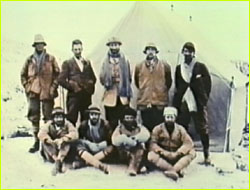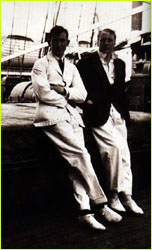
|
 |
 |
by Audrey Salkeld "The experiment of the expedition is Mr. Irvine . . . . His record at Spitsbergen last year and his really remarkable physique, to say nothing of his reputation as a general handyman, justify the experiment we are making in exposing one of his tender years to the rigours of Tibetan travel. We entertain no fears on this account . . . ."Andrew Irvine, known to family and friends as "Sandy," was two months into his 23rd year when he disappeared on Everest with George Mallory. An engineering student, he was on two month's leave from Merton College, Oxford. Whenever the tragedy is recalled, it has always been Mallory's name that springs to mind. Irvine comes almost as an appendix—Mallory-and-Irvine. In a way, this is hardly surprising. Mallory was already a hero in the public's eyes when he went to Everest in 1924 and, after all, what time has a 22-year old had to make much of a mark on the world? Yet today, 75 years after the two men were lost, the mystery still tantalizes, and there are people who wonder about the young man whose fate was inextricably linked with the ever-charismatic Mallory. Irvine's former school, Shrewsbury, will be holding commemorative events this summer to mark the anniversary of his death and staging an exhibition to celebrate one of its most intriguing old boys. Irvine's first biography is being written.
Irvine, from a well-to-do Birkenhead family, was the second of five brothers. His sister Evelyn, who in age came between him and his eldest brother, was perhaps the sibling to whom he was closest. After his death, some garnets that Irvine had collected for her in Tibet were forwarded on by his Sherpa. The year before, when he had been to Spitsbergen with an Oxford University expedition, he brought her home an eider-feather quilt. Always tall for his age, he was good at games and good-looking. "A little vain, and something of a dandy," one of his brothers remembered fondly, "quite a lady's man. When he was lost on Everest several young ladies claimed to have been engaged to him." His partiality for wearing spats was also recalled, and it is interesting to notice in some of the trek-in photographs, in which his companions have their legs bound in the recommended Kashmiri puttees, Irvine sports what look like Highland-issue spats (worn with long shorts). His modest assurance endeared him to his fellow-expeditioners—"neither bumptious by virtue of his 'blue' (for rowing), nor squashed by the age of the rest of us," Hugh Somervell has written—even so, at times he may well have felt isolated from the experience of the others and by his own lack of intellectualism. Whereas his brothers were academically inclined, Irvine was more practically gifted. They used to rag him for "not being very bright," but conceded he had a natural instinct for method study or lateral thinking, and this was demonstrated clearly on Everest when he saw that the way to save weight on the bulky oxygen apparatus was to turn the cylinders the other way around in the carrying frame, thereby doing away with a lot of the awkward piping. Irvine's selection for Everest was made on the recommendation of Noel Odell, who had been impressed with his performance in Spitsbergen and testified to his strengths, resourcefulness, and general good nature. As Mallory wrote to his friend, Geoffrey Winthrop Young, when the team was announced, "Irvine represents our attempt to get one superman, though lack of experience is against him."
I had a perfectly wonderful time... [and] came back whole from Mürren—I never thought I would—I took the Nose Dive straight my 2nd day and Lone Tree my 3rd and stood which shook some of the expert skiers to the core. I got the nickname of the Human Avalanche, so you can guess how I crashed about!! God it's a good place—I'm dying to go again. Aren't the mountains wonderful, just asking to be climbed, and real Spitsbergen colouring in the evenings.The question is often asked: Why did Mallory choose Irvine as partner for that final summit bid? Why not Odell, for instance, who had far more mountain experience? The generally accepted response is that Irvine's mechanical genius was essential to keep the notoriously temperamental oxygen apparatus functioning, and Mallory intended this to be an oxygen-assisted attempt (having just seen two non-oxygen attempts fail). Personally, I have doubts any choice was made at all; I don't believe it occurred to Mallory to consider taking anyone but Irvine. From the outset, he'd dreamed of surmounting the mountain with Irvine ("on Ascension Day") and he'd written to his mother from Tibet to say what a star young Irvine was proving to be, "a very fine fellow, [who] has been doing excellently up to date, and should prove a splendid companion on the mountain. I should think the Birkenhead News—is it?—ought to have something to say if he and I reach the top together." (Mallory's family also lived in Birkenhead.)
Photos: (1,3) Salkeld Collection; (2,4) Courtesy of the John Noel Photographic Collection. Lost on Everest | High Exposure | Climb | History & Culture | Earth, Wind, & Ice E-mail | Previous Expeditions | Resources | Site Map | Everest Home Editor's Picks | Previous Sites | Join Us/E-mail | TV/Web Schedule About NOVA | Teachers | Site Map | Shop | Jobs | Search | To print PBS Online | NOVA Online | WGBH © | Updated November 2000 |
 Andrew "Sandy" Irvine
Andrew "Sandy" Irvine
 Irvine, far left, standing with the 1924 expedition.
Irvine, far left, standing with the 1924 expedition.
 Irvine (right) with Mallory aboard the SS California,
which carried the 1924 expedition from Liverpool to
Bombay.
Irvine (right) with Mallory aboard the SS California,
which carried the 1924 expedition from Liverpool to
Bombay.
 The last photograph of Irvine and Mallory shows the
two preparing for their final summit attempt.
The last photograph of Irvine and Mallory shows the
two preparing for their final summit attempt.
